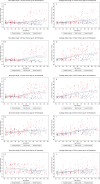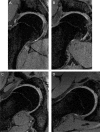Physical activity during adolescence and the development of cam morphology: a cross-sectional cohort study of 210 individuals
- PMID: 28798039
- PMCID: PMC5909766
- DOI: 10.1136/bjsports-2017-097626
Physical activity during adolescence and the development of cam morphology: a cross-sectional cohort study of 210 individuals
Abstract
Introduction: Cam morphology is a strong risk factor for the development of hip pain and osteoarthritis. It is increasingly thought to develop in association with intense physical activity during youth; however, the aetiology remains uncertain. The study aim was to characterise the effect of physical activity on morphological hip development during adolescence.
Methods: Cross-sectional study of individuals aged 9-18 years recruited from Southampton Football Club Academy (103 male) with an age-matched control population (52 males and 55 females). Assessments included questionnaires and 3 Tesla MRI of both hips. Alpha angle, epiphyseal extension and epiphyseal tilt were measured on radial images.
Results: Alpha angle and epiphyseal extension increased most rapidly between ages 12 and 14 years. Soft-tissue hypertrophy at the femoral head-neck junction preceded osseous cam morphology and was first evident at age 10 years. The greatest increase and highest absolute values of alpha angle and epiphyseal extension were colocalised at 1 o'clock. Maximum alpha angles were 6.7 degrees greater in males than females (p=0.005). Compared with individuals who play no regular sport, alpha angles were 4.0 degrees higher in individuals who play sport for a school or club (p=0.041) and 7.7 degrees higher in individuals competing at a national or international level (p=0.035). There was no association with leg dominance .
Conclusions: Sporting activity during adolescence is strongly associated with the development of cam morphology secondary to epiphyseal hypertrophy and extension with a dose-response relationship. Males participating in competitive sport are at particularly elevated risk of developing cam morphology and secondary hip pathology.
Keywords: MRI; football; hip; physical activity; sport.
© Article author(s) (or their employer(s) unless otherwise stated in the text of the article) 2018. All rights reserved. No commercial use is permitted unless otherwise expressly granted.
Conflict of interest statement
Competing interests: None declared.
Figures




References
-
- Kienle KP, Keck J, Werlen S, et al. . Femoral morphology and epiphyseal growth plate changes of the hip during maturation: MR assessments in a 1-year follow-up on a cross-sectional asymptomatic cohort in the age range of 9-17 years. Skeletal Radiol 2012;41:1381–90. 10.1007/s00256-012-1358-9 - DOI - PubMed
MeSH terms
LinkOut - more resources
Full Text Sources
Other Literature Sources
Medical
